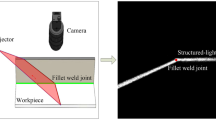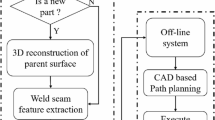Abstract
By using depth from focus (DFF) alone to obtain the 3D wear area reconstruction of grinding wheel, the depth values in the 3D wear area image are not continuous while by using shape from shading (SFS) alone, the 3D wear area cannot be fully obtained. A novel method that uses Fourier transform to fuse the methods of DFF and SFS is proposed in this paper. The proposed method can achieve depth continuity in tool wear images. After performing high-pass filtering and low-pass filtering for the 3D reconstructed images of DFF and SFS, respectively, in frequency domain, the 3D wear area reconstruction image of grinding wheel can then be obtained by Fourier inversion. Experimental results showed that the 3D wear area reconstruction image obtained by the proposed method can achieve better accuracy for the tool wear volume than using DFF or SFS alone. And the efficiency of the proposed method is proved to be better than microscopes.
Similar content being viewed by others
References
Hao Z, Fan Y, Lin J, Yu Z (2015) Wear characteristics and wear control method of PVD-coated carbide tool in turning Inconel 718. Int J Adv Manuf Technol 78:1329–1336
Wei X, Qi L, Zhou J, Ju L, Tian W (2015) Tool wear morphologies and mechanisms for cutting Cf/Mg composites. Int J Adv Manuf Technol 1–7 (in press)
Cui X, Zhao J, Dong Y (2013) The effects of cutting parameters on tool life and wear mechanisms of CBN tool in high-speed face milling of hardened steel. Int J Adv Manuf Technol 66:955–964
Ahmad MB, Choi TS (2007) Application of three dimensional shape from image focus in LCD/TFT displays manufacturing. IEEE Trans Consum Electron 53:1–4
Kim GB, Tian GY (2009) A novel depth-from-focus-based measurement system for the reconstruction of surface morphology with depth discontinuity. Int J Adv Manuf Technol 40:1158–1165
Subbarao M, Tyan J-K (1998) Selecting the optimal focus measure for autofocusing and depth-from-focus. IEEE Trans Pattern Anal Mach Intell 20:864–870
Huang W, Jing Z (2007) Evaluation of focus measures in multi-focus image fusion. Pattern Recogn Lett 28:493–500
Tian J, Chen L, Ma L, Yu W (2011) Multi-focus image fusion using a bilateral gradient-based sharpness criterion. Opt Commun 284:80–87
Zhou Z, Li S, Wang B (2014) Multi-scale weighted gradient-based fusion for multi-focus images. Inf Fusion 20:60–72
Rajabi MA, Blais JR (2004) Optimization of DTM interpolation using SFS with single satellite imagery. J Supercomput 28:193–213
Zhang L (2006) RestoringWarped Document Images using Shape-from-Shading and Surface Interpolation. In IEEE 18th International Conference on Pattern Recognition. p. 642–645
Courteille F, Durou J-D, Morin G (2006) A global solution to the SFS problem using B-spline surface and simulated annealing. In IEEE 18th International Conference on Pattern Recognition. p. 332–335
Horn BK (1970) Shape from shading: a method for obtaining the shape of a smooth opaque object from one view. Massachusetts Institute of Technology
Quanying D, Shanben C, Tao L (2006) Inspection of weld shape based on the shape from shading. Int J Adv Manuf Technol 27:667–671
Geng P, Gao Z, Hu C (2013) Multi-focus image fusion using the local neighbor sum of Laplacian in NSCT domain. Int J Sig Processing, Image Process Pattern Recog 6:69–80
Ping-Sing T, Shah M (1994) Shape from shading using linear approximation. Image Vis Comput 12:487–498
Author information
Authors and Affiliations
Corresponding author
Additional information
Aibin Zhu, Dayong He and Jianwei Zhao contributed equally to this work.
Rights and permissions
About this article
Cite this article
Zhu, A., He, D., Zhao, J. et al. 3D Wear Area Reconstruction of Grinding Wheel by Frequency-Domain Fusion. Int J Adv Manuf Technol 88, 1111–1117 (2017). https://doi.org/10.1007/s00170-016-8846-3
Received:
Accepted:
Published:
Issue Date:
DOI: https://doi.org/10.1007/s00170-016-8846-3




